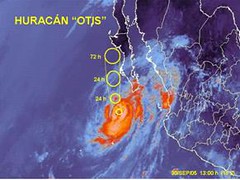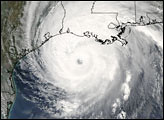These forecasts were compiled between August 21, 2005 and September 6, 2005.
AtlanticNovember 5-7, 2005:Forecast: Tropical storm and/or
hurricane development or passage is imminent
around 72 West Longitude and
22 North Latitude. This is roughly 160 miles north of Haiti and somewhat southwest of the Bahamas. It may be a broad weather pattern that affects
Hispanola and/or
south of it.
November 5-6, 2005:Forecast: The potential for
tropical storm formation is indicated
around 50 West Longitude and
8 North Latitude.
November 20-21, 2005:Forecast: Tropical activity possible in and
around 50 West Longitude and
8 North Latitude.
November 22-24, 2005:Forecast: Tropical storm or
hurricane formation is likely along
63 West Longitude and
20 North Latitude. This lies about
265 miles northeast of
Puerto Rico.
CaribbeanNovember 1-2, 2005:Forecast: Watch for
heavy rains or a
tropical system over area comprising
Jamaica and
eastern Cuba.
November 12-15, 2005:Forecast: It seems that a
tropical weather system, be it a tropical wave, storm etc., or other severe weather pattern will affect
Hispañola.
November 23-24, 2005:
Forecast: Tropical storm or
heavy rains for the area
around Jamaica and
eastern Cuba.U.S. Mainland
November 2-4, 2005:Forecast: A
cold Canadian air mass will sink southward over
the northern Plains States with the potenial for triggering
storms over the
Dakotas, Minnesota, Nebraska, and
Iowa.
November 2-4, 2005:Forecast: A
chilly air mass from northern regions will descend over the
Northeast U.S. and generate
wet and
soggy conditions as it interacts with a moisture already in place.
November 3-5, 2005:Forecast: A
strong cold front will push into the
West Coast area bringing
rain and
colder temperatures as it progresses through the
Intermountain West.
The
Rockies will eventually feel the brunt of this system especially over
Utah and
Colorado.
November 5-7, 2005:Forecast: Another round of
storms batters the
West Coast States. Moist, warm air finds its way over the region producing "caffeinated" storms over the
Intermountain West.
Forecast: As warm,
moist air is funneled northward over the
Plains, colder, drier air rushes southward over the
Mississippi Valley. The inevitable result is that
storms will erupt over both these areas as the colder air collides with this southerly invasion. Watch, in particular, for
strong storms over the
Arrowhead of Minnesota.
Gusty winds usually accompany this pattern.
Forecast: Cold and
windy conditions, originating in the central U.S., rush eastward toward the
eastern Great Lakes,
Mid-Atlantic, and
Southeast.
Forecast: New England may be dealing with a weather phenomenon all its own. One forecast model indicates a
storm system south of Maine, roughly at the latitude of Washington DC, that
heads northward toward New England. This may represent a
Nor’easter or a
tropical system.November 11-13, 2005:Forecast: Cool and
fair conditions are shown for the
eastern portion of the country most likely courtesy of a
high pressure system over
Canada or the
Great Lakes area.
November 13-15, 2005:Forecast: Rising temperatures over the
Intermountain West may erupt in
thunderstorms.
November 14-17, 2005:Forecast: The incursion of
colder air over the
eastern half of the
country and consequent
tumbling temperatures will necessitate
frost and
feeze advisories over the region. The
16th and
17th appear to be high points when
cold air and
windy conditions will manifest over the
Mississippi Valley area.
November 15-17, 2005:Forecast: An
active weather pattern is promised for the
Rockies as
moisture is drawn up
from the
Gulf of California sparking
severe thunderstorms over
Arizona, Utah, and
surrounding areas.
November 17-18, 2005:Forecast: A
robust weather system hits the
West Coast as atmospheric conditions deteriorate resulting in a round of
severe weather.
Forecast: Strong storms will bully the
Plains States as conflicting atmospheric currents lay into each other.
November 19-20, 2005:Forecast: Another bout of
blustery weather and
lower temperatures is shown for the
Mississippi Valley and
eastern U.S.November 20-22, 2005:Forecast: Another
vigorous storm system will intensify over the
West Coast States resulting in
cold and
wet conditions.
November 21-24, 2005:Forecast: This promises to be a
very active period for the
Plains. The necessary ingredients to produce
blizzard-like conditions seem to be present over the
Northern Tier States.
November 23-25, 2005:Forecast: Chilly air and
blustery winds will whip the
Rockies calling for high wind and winter storm warnings over the region.
November 23-24, 2005:Forecast: The clash between high and low pressure systems will focus on the
coastal areas of
Virginia and
North Carolina.
High winds or
severe storms are likely to hit this area. This may be part of a larger weather pattern that affects the
Mid-Atlantic area.
November 27-29, 2005:Forecast: A
cool high pressure area will enter the
West Coast. This
drier air mass
may ignite some
storms and
windy conditions in its attempt to establish itself over the region.
Forecast: Increasing wind speeds and
falling temperatures will be the story from the
western Great Lakes, across the
Mississippi Valley, and
eastward as cold Canadian air pushes southward. This weather pattern will extend across the
eastern Great Lakes and into the
Mid-Atlantic area etc.
Inclement weather is also shown over
northwest Texas.

